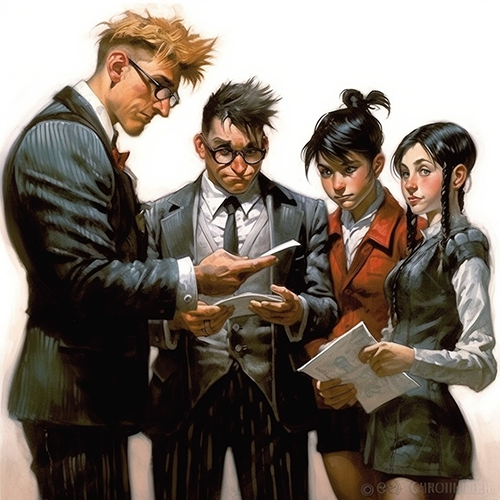
The report by well-known consulting firm McKinsey, The economic potential of generative AI: The next productivity frontier (June 2023), provides reliable information and analysis on the jobs potential of ChatGPT and other generative Ai. The analysis and projections are encouraging. This report is much needed because almost everyone’s initial reaction to the surprising superpowers of generative Ai, is an “on no” type of response concerning job loss. We all tend to jump to fear of replacement by super smart Ai. Good news! The McKinsey report shows that is wrong. The conclusion is based on careful study, and extensive, fact checked research by top human experts. The report should encourage lawyers to embrace the coming Ai change, not fear it.

The McKinsey Report
The well-written report by McKinsey & Company is a collaborative effort by many authors: Michael Chui, Eric Hazan, Roger Roberts, Alex Singla, Kate Smaje, Alex Sukharevsky, Lareina Yee, and Rodney Zemmel. It begins with, “Generative AI is poised to unleash the next wave of productivity. We take a first look at where business value could accrue and the potential impacts on the workforce.” The report then introduces seven key insights.
1. Generative AI’s impact on productivity could add trillions of dollars in value to the global economy. Our latest research estimates that generative AI could add the equivalent of $2.6 trillion to $4.4 trillion annually across the 63 use cases we analyzed. (Author’s Note – use cases considered do not include law.)
2. About 75 percent of the value that generative AI use cases could deliver falls across four areas: Customer operations, marketing and sales, software engineering, and R&D.
3. Generative AI will have a significant impact across all industry sectors.
4. Generative AI has the potential to change the anatomy of work, augmenting the capabilities of individual workers by automating some of their individual activities.
5. The pace of workforce transformation is likely to accelerate, given increases in the potential for technical automation.
6. Generative AI can substantially increase labor productivity across the economy, but that will require investments to support workers as they shift work activities or change jobs.
7. The era of generative AI is just beginning.
McKinsey, The economic potential of generative AI: The next productivity frontier (June 2023)

The McKinsey report defines up front what it means by “Generative AI” and ties it to “foundation models” patterned on the “neural net” synapses used by our brains. Generative AI copies the basic connecting neuron brain structure to create intelligent AI, but, due to current computing limitations, they have to use far fewer neuron switches, thousands or at least hundreds of times fewer switches, than we have in our brain. (Go humans!) Humans have from between 100 Trillion synapses, to 1 Quadrillion synapses (That’s a thousand trillion.) The GTPs today have only a couple of hundred Billions synapse equivalents, parameters. For instance, ChatGPT-3.5 has only 175 billion. The size of GPT-4.0 is a trade secret, aside from OpenAI saying that it has attained a substantial increase over the 3.5. Version. Still, version 4.0 is rumored to have 1 Trillion parameters.



That is still quite smaller than us. Now here are some of the McKinsey report definitions.
For the purposes of this report, we define generative AI as applications typically built using foundation models. These models contain expansive artificial neural networks inspired by the billions of neurons connected in the human brain. Foundation models are part of what is called deep learning, a term that alludes to the many deep layers within neural networks. Deep learning has powered many of the recent advances in AI, but the foundation models powering generative AI applications are a step change evolution within deep learning.
McKinsey Report at pg. 5
A part of the report on knowledge workers like lawyers that I found particularly interesting, concerned Generative AI as a virtual collaborator.
In other cases, generative AI can drive value by working in partnership with workers, augmenting their work in ways that accelerate their productivity. Its ability to rapidly digest mountains of data and draw conclusions from it enables the technology to offer insights and options that can dramatically enhance knowledge work. This can significantly speed up the process of developing a product and allow employees to devote more time to higher-impact tasks. Generative AI could increase sales productivity by 3 to 5 percent of current global sales expenditures.
McKinsey Report at pg. 19
This productivity increase has been my experience to date, and that of other tech lawyers I have spoken with. It does, however, require prompt skills, in other words, you have to know what you are doing. See: OpenAI’s Best Practices For Using GPT Software.
The last interesting part in the Report for those whose expertise is in the “vertical” of law, which was not included the Report analysis, is the segment entitled: “The generative AI future of work: Impacts on work activities, economic growth, and productivity.” Report pg. 32. It applies to work in general, including knowledge workers otherwise omitted from the Report, such as lawyers. “Generative AI is likely to have the biggest impact on knowledge work, particularly activities involving decision making and collaboration, which previously had the lowest potential for automation.” Report at pg. 39. That is the key high level function of lawyer work, “decision making and collaboration.” See the below Exhibit 10 of the report at page 40 for the chart that summarize the surprising stats on this.

The next chart, Exhibit 11, finally includes a line, among many, that at least includes the legal profession as “part of” an occupation, “business and legal professionals.” The chart states the share of global employment (47 countries) for this professionals group is 5%. The chart predicts the overall technical automation potential is likely to grow by 62% with generative AI, whereas with other prior technology, including AI that is not generative AI (meaning basically the tech before 2023) was 32%. So the advent of ChatGPT and related, yet to be released generative AI is expected to double the automation potential of business and legal professionals. If they were to drill down to the U.S. alone and to the legal profession alone, I expect the number would be even higher, conservatively up to 75%. So, if you study the report carefully (and I personally did all of this analysis and writing, not “neuron weak” ChatGPT), it is suggesting that three fourths of lawyer tasks have the potential to be automated. It does not give a time frame for how long it might take this potential to be realized. Still, think of the implications of McKinsey’s study.
One more quote from the report is already well-known but bears repetition:
Labor economists have often noted that the deployment of automation technologies tends to have the most impact on workers with the lowest skill levels, as measured by educational attainment, or what is called skill biased. We find that generative AI has the opposite pattern— it is likely to have the most incremental impact through automating some of the activities of more-educated workers. . . .
However, generative AI’s impact is likely to most transform the work of higher-wage knowledge workers because of advances in the technical automation potential of their activities, which were previously considered to be relatively immune from automation.
McKinsey, Report. at pgs. 42 and 43.
To state the obvious, the legal profession in the U.S., which requires a graduate degree, is one of the most educated, higher-wage occupations in the world. That puts us near the tip of the spear.


The Report goes on to conclude that unlike all other automation technologies that have come before: “The rapid development of generative AI is likely to significantly augment the impact of AI overall, generating trillions of dollars of additional value each year and transforming the nature of work.” Report pg. 48. McKinsey goes on to caution, as it should:
But the technology could also deliver new and significant challenges. Stakeholders must act—and quickly, given the pace at which generative AI could be adopted—to prepare to address both the opportunities and the risks. Risks have already surfaced, including concerns about the content that generative AI systems produce: Will they infringe upon intellectual property due to “plagiarism” in the training data used to create foundation models? Will the answers that LLMs produce when questioned be accurate, and can they be explained? Will the content generative AI creates be fair or biased in ways that users do not want by, say, producing content that reflects harmful stereotypes? (emphasis added by Author.)
McKinsey Report. at pg.48.
Loss of Some Jobs in the Law is Probable and Not Such a Bad Thing
What is the probable impact of generative Ai on the legal industry? As shown, the McKinsey report does not specifically address our profession. But that’s ok, that is the area we already know about. Lots of us have been thinking about this for decades. In Law the job that is typically mentioned as the one most likely to be replaced by Ai is document review in discovery. In fact, employment in this area has already been disrupted by predictive coding, well before generative AI. I have a lot of personal experience with that. The impact will soon accelerate.
This part of the popular analysis about legal job disruption is correct, but, the negative reaction is misplaced. It is a mistake to think of “all the poor contract document review attorneys who will lose their job.” I have compassion for these contract review attorneys, in fact, I favor short term financial assistance for them, but I do not feel bad about their having to get a new job. I have personally done hundreds of document reviews over my career, supervised many thousands, and spent about a thousand hours myself actually doing doc reviews, often non-billable. I don’t know of any other big law partner who is dumb enough to have done that. But I did. Sometimes boring work is calming. Plus it needed to be done.

I was fortunate to have been paid pretty well for this, but the typical contract reviewer works ten hour days for compensation that is, after all deductions, just a hair above minimum wage. No kidding. The low compensation is a disgrace. As a consequence, most contract reviewers just doze around on a computer, trying to stay awake, reading company emails and messages to judge relevance and privilege at a snails pace of fifty files per hour. So boring, most of the time.


This work is much better suited for Ai, where reliable review of 50 files per minute is coming soon. My specialized, highly skilled teams of reviewers were able to attain these speeds, even higher, years ago, just by using predictive coding and our hybrid multimodal methods. With generative Ai these speeds will increase, reliability will increase, and, here is the big change, it should be far easier to do.

The pre-automation, grueling, mental labor task of trained lawyers manually reading hundreds of thousands of documents all day for possible use of a few of them at trial, is a task that should be eliminated. This particular lawyer job, which did not even exist until well into this century, is going away fast. “Good riddance,” I say. Some doc review jobs will remain, but never again the mobs of bored stiff law grads. With Ai, one human document reviewer will be able to supervise and do the work of dozens of unassisted lawyers, of hundreds, of thousands. We should not feel bad about the elimination of such boring, low paid drudgery work. I have done this work. It is awful. Far better to delegate it to intelligent robots.

We Should Prepare Now for Accelerated Job Displacement
I know and have worked with lots of doc reviewers. They are smart people; they have a law degree. It is demeaning to force them to do such legal work to earn a living. Many in the U.S. are burdened by crazy high student debt from greedy law schools, often low ranked, but still, they have a degree. They graduated from law school and most, like ChatGPT-4, have also passed a Bar exam. Moreover, unlike any Ai, they have also passed an ethics exam and personal history review and have been admitted to a state Bar association.
These low paid doc reviewers have good language skills and intelligence and, this is important, by completing law school, they have demonstrated an ability to learn new things, complicated things. Moreover, the legal training they received on ethics, research, persuasion, evidence, reasoning, logic and analysis, is transferable to a lot of new work, for instance, prompt engineering. They can, and should, retool. Their current employers should help them with that, including especially e-discovery vendors, So should the whole legal industry. The help should begin with financial and retraining assistance for the most vulnerable group, contract review lawyers, but should not stop there. A lot of lawyers need help today, and there will be many more in the near future. Retooling and ongoing education is necessary for most everyone today, including senior partners in law firms.

The same replacement situation applies to the legal work of reviewing and writing large, complex contracts, except that those attorneys are usually associates or junior partners in law firms, not outcast contract lawyers, and they are paid far more than doc reviewers. Most legal tech experts predict, and I agree, that lawyers who perform this function will also soon be replaced, or numbers greatly reduced. Another mind numbing law job will bite the dust. I have done that too, from preparing shopping center leases, to software licenses, to the worst of them all, zillion page ERISA plans. Lots of boring tasks in the law and other areas will go away, or be greatly reduced by generative Ai. But here is the point of the McKinsey study, many more new and interesting tasks and jobs will be created by Ai. Overall it is a big 4.4 Trillion Dollar win.



Conclusion
The McKinsey Report provides clear warning of the coming storm of generative Ai. There are great opportunities and dangers. McKinsey is trying to prompt all of us to take action now. Quick action does not come easily to the legal profession. Lawyers suffer from a common affliction of the over-educated, paralysis by analysis. We tend to think too much and act too little. We are consumed with the fear of making a mistake. That is especially true when thinking about something new and strange.



In times of rapid change, like we are living through now, we must resist the temptation to just sit back and do nothing, or worse, appoint a committee to study the situation. Long gone are the leisurely days of taking years to consider and implement new rules and procedures in the law. If the legal profession is to make a smooth transition, not only survive, but prosper and provide the justice services our world desperately needs, then we must all realize that weakness. As McKinsey concluded, all of us must act-and quickly, given the pace of generative AI adoption.

Bar associations, courts, judges, arbitrators, arbitration associations, law firms (especially Big Law), in-house counsel, mediators, lawyers, paralegals, consultants, legal tech experts, and legal tech vendors, especially vendors who provide, or provided, document review services, need to start taking action now. They need to prepare new rules to govern generative Ai and they need to start retooling efforts and financial aid efforts to help unemployed lawyers in need. Big law and e-discovery vendors have profited greatly by the sweat of document reviewers over the years, and they should, along with Bar Associations, take the lead in financial aid efforts. We should start setting up charitable fund and equitable distribution systems now. Morally speaking the Ai industry should also be a major contributor to the retooling and financial aid efforts for all industries they disrupt, including the legal industry. They will receive a large share of the $4.4 Trillion. They too need to open their wallets and start taking action.
We need to formulate rules and best practices for use of generative Ai. At the same time, we need to plan for temporary job displacement and start taking action on that front. We should think about establishing free, or at least heavily subsidized, re-training programs. We should start to set up charitable programs for lawyers, and their families, who will soon be in need of temporary financial aid. The forthcoming $4.4 Trillion windfall that McKinsey predicts will inevitable hurt many in the short-term. The legal and technology industries should help. We should not be too hasty about any of this, we have a few months. We need some discussion, some time for deliberation, but not too much.
The world is depending on a functional system of justice. Legal work is important. It is too dangerous for us to remain in the mental world and just talk and write. As always with justice, balance is the way. New technology is a moving target, I know, but if mistakes are made, and they will, we can always adjust and revise. Let us be proactive and do what no Ai can now do, take the initiative and do things in the real world.


Ralph Losey Copyright 2023 – ALL RIGHTS RESERVED — (Published on edrm.net and jdsupra.com with permission.)


